Minimally invasive surgery could be attempted with preoperatively predictable difficulty for non–small cell lung cancer after neoadjuvant immunochemotherapy: A large multicenter study
IF 2.7
2区 医学
Q1 SURGERY
引用次数: 0
Abstract
Background
Neoadjuvant immunochemotherapy has revolutionized the treatment of non–small cell lung cancer. However, it presents significant surgical challenges, leading to controversy over the feasibility and safety of minimally invasive surgery. This study aims to assess the adequacy of minimally invasive surgery and preoperatively predict its difficulty for non–small cell lung cancer after neoadjuvant immunochemotherapy.
Methods
Initial stage IIA-IIIB (excluding stage T4N2) non–small cell lung cancer patients with neoadjuvant immunochemotherapy undergoing minimally invasive surgery or open thoracotomy at 12 institutions between 2019 and 2024 were retrospectively reviewed. Difficult minimally invasive surgery was defined by conversion to thoracotomy. Propensity score matching was applied to balance baseline characteristics.
Results
Of the 571 cases included, propensity score matching led to 240 patients per group. Minimally invasive surgery decreased intraoperative bleeding, shortened postoperative chest tube duration and hospitalization, ameliorated postoperative pain, and reduced postoperative complications compared to open thoracotomy. Moreover, minimally invasive surgery had an acceptable conversion rate of 15.8%, and notably, converted minimally invasive surgery achieved similar perioperative outcomes to open thoracotomy. Accumulated surgeons' experiences reduced minimally invasive surgery conversion rates and shortened surgical durations. Additionally, logistic regression identified squamous cell carcinoma, advanced preinduction N stage, preoperative tumor size >5 cm, advanced preoperative stage, and extended resection as independent risk factors for conversion. A nomogram was further established with good performance (area under curve value = 0.804) and clinical utility to predict conversion probability preoperatively. Finally, minimally invasive surgery and open thoracotomy achieved comparable event-free survival and overall survival profiles.
Conclusions
Minimally invasive surgery achieved improved perioperative outcomes and similar oncologic efficacies to open thoracotomy. Moreover, minimally invasive surgery had an acceptable conversion rate, which would not compromise perioperative outcomes compared with open thoracotomy and could be effectively forecasted by a prediction model.

新辅助免疫化疗后的非小细胞肺癌可尝试微创手术,但术前可预测的困难:一项大型多中心研究
新辅助免疫化疗已经彻底改变了非小细胞肺癌的治疗。然而,它提出了重大的手术挑战,导致对微创手术的可行性和安全性的争议。本研究旨在评估非小细胞肺癌新辅助免疫化疗后微创手术的充分性及术前预测微创手术的难度。方法回顾性分析2019年至2024年12所医院接受新辅助免疫化疗的IIA-IIIB期(不包括T4N2期)非小细胞肺癌微创手术或开胸手术患者。微创手术的难点在于转换为开胸手术。倾向评分匹配用于平衡基线特征。结果纳入的571例患者中,倾向评分匹配每组240例。与开胸手术相比,微创手术减少术中出血,缩短术后胸管时间和住院时间,改善术后疼痛,减少术后并发症。此外,微创手术的可接受转换率为15.8%,值得注意的是,转换微创手术的围手术期结果与开胸手术相似。外科医生经验的积累降低了微创手术转换率,缩短了手术时间。此外,logistic回归发现鳞状细胞癌、晚期诱导前N期、术前肿瘤大小>; 5cm、晚期术前分期和延长切除是转化的独立危险因素。进一步建立了具有良好性能(曲线下面积= 0.804)和临床应用价值的nomogram术前预测转换概率。最后,微创手术和开胸手术的无事件生存率和总生存率相当。结论微创手术围手术期疗效优于开胸手术,肿瘤疗效与开胸手术相近。此外,微创手术具有可接受的转换率,与开胸手术相比不会影响围手术期的预后,并且可以通过预测模型进行有效预测。
本文章由计算机程序翻译,如有差异,请以英文原文为准。
求助全文
约1分钟内获得全文
求助全文
来源期刊

Surgery
医学-外科
CiteScore
5.40
自引率
5.30%
发文量
687
审稿时长
64 days
期刊介绍:
For 66 years, Surgery has published practical, authoritative information about procedures, clinical advances, and major trends shaping general surgery. Each issue features original scientific contributions and clinical reports. Peer-reviewed articles cover topics in oncology, trauma, gastrointestinal, vascular, and transplantation surgery. The journal also publishes papers from the meetings of its sponsoring societies, the Society of University Surgeons, the Central Surgical Association, and the American Association of Endocrine Surgeons.
 求助内容:
求助内容: 应助结果提醒方式:
应助结果提醒方式:


